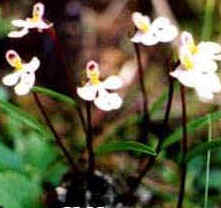|
|
|||
|
Key
for cultivation end of page |
 |
Coloured signs no frost |
Prices in Ä |
|
Aminostigma |
|||
| brevicalcarata (Orchis) |
lilac and pink flowers | PE |
F 15,- |
| white, yellow and pink flowers | PE |
F 15,- |
|
| light pink flowers | PE |
F 15,- |
|
| keiskei var. |
very large pink flowers | PE |
F 20,- |
| lepidum |
white and red flowers | PE |
F 15,- |
| large yellow flowers | PE |
F 18,- |
|
| sp.1 |
green flowers | PE |
F 15,- |
| sp.2 |
lilac flowers, spotted leaves | PE |
F 20,- |
| sp.3 (Orchis chusua) |
lilac flowers | PE |
F 15,- |
Bletia |
|||
purpurata x Bletilla Penway Sunset |
|
B |
1y 5,- |
|
Bletilla |
|||
| striata blue |
blueish flowers, selected clone |
B |
F 5,- |
| variation with large flowers |
B |
F 15,- |
|
| colourful species |
B |
F 20,- |
|
| striata var. |
white flowered | B |
F 15,- |
| Sunset x ochracaea | B | 1y 5,- | |
|
Bonatea |
|||
| speciosa |
large white flowers |
Ea |
F 20,- |
Brownlea |
|||
coerulea |
pretty mauve flowers |
Ea |
1y 8,- |
|
Caladenia |
|||
| patersonii var |
large white flowers |
Ca |
1y 4,- |
|
Calanthe |
|||
| alismaefolia |
white flowers |
J |
F 20,- |
| rare in cultivation |
J |
F 22,- |
|
| bicolor |
showy clone, white and red flowers |
J |
F 20,- |
| red form of bicolor |
J |
F 25,- |
|
| selection of japanese growers,very colourful |
J |
F 30,- |
|
| `Yoroz`x bicolor |
very colourful |
J |
2y 18,- |
| bicolor x sieboldii |
laege yellow and orange coloured flowers |
J |
F 20,- |
| white flowers, red lip, large plants |
J |
F 25,- |
|
| interesting shaped flowers |
J |
F 25,- |
|
| discolor red |
red selection of famous discolor |
J |
F 30,- |
| fargesii |
yellow flowers, brown striped petals |
J |
F 30,- |
| fimbriata |
pretty flowers, lilac with yellow |
J |
F 30,- |
| hancockii |
large brown yellow flowers |
J |
F 30,- |
| large lilac - red flowers |
J |
F 30,- |
|
| okinawaensis 4pl x masuca |
showy hybrid, large lilac - red flowers |
J |
F 30,- |
| oblanceolata |
great plants, easy to cultivate |
J |
F 25,- |
| puberula |
delicious flowers |
J |
F 30,- |
| reflexa |
pretty pink and lilac flowers |
J |
F 20,- |
| tall inflorence with red and green flowers |
J |
F 18,- |
|
Himantoglossum |
||||
|
This conditions are guilty for central europe Ca:
( Caladenia ) Ea:
( ground orchids from mountain eastern Africa as
Bonatea and some Disas) J: ( Japanese and
asian woodland orchids )
4pl.= tetraploid plants, often greater flowers . If known motherplant of hybrids at first in name . |